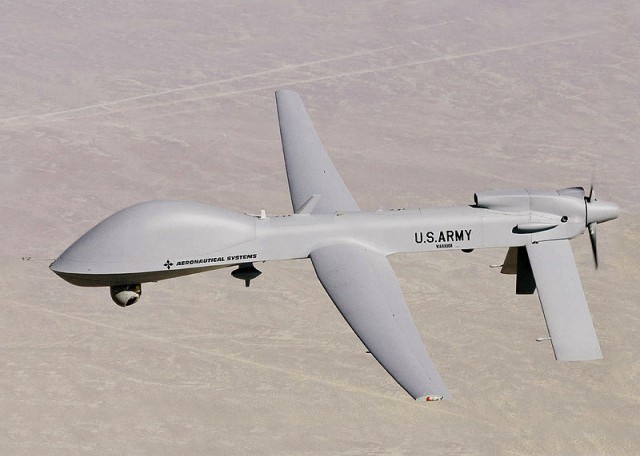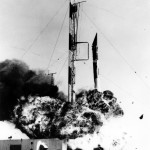
On July 5, the US Army announced it had completed a two-week demonstration of a new ground-based sensor system for its MQ-1C Gray Eagle unmanned aerial system (UAS) that will allow UAS operators to detect and avoid other aircraft. The Army is now ready to begin the certification process with the Federal Aviation Administration to allow the Grey Eagle—formerly known as the Warrior—to fly unfettered in domestic airspace. The Army expects to start flying the UASs in domestic airspace for training by March of 2014.
The $90 million Grey Eagle is a descendant of the Predator and manufactured by General Atomics. The aircraft is a medium-range multipurpose UAV that has seen duty in Afghanistan with the Army. In the demonstrations held at the Army’s Dugway Proving Grounds in Utah, the MQ-1C was tested with the Ground Based Sense and Avoid (GBSAA) system, a ground-based radar that monitors the UAV and the aircraft around it.
The GBSAA system will be deployed at five bases around the US where Gray Eagle squadrons will be home-based. Fort Hood, Texas will get the first installation, followed by Fort Riley, Kansas. Fort Stewart in Georgia, Fort Campbell in Kentucky, and Fort Bragg in North Carolina will get their GBSAA systems by 2015.
The Army’s announcement comes as the FAA faces a looming deadline to come up with a plan to integrate unmanned aerial vehicles into its regulations for domestic aircraft. Congress put a mandate into the FAA Modernization and Reform Act, signed in February, that requires the FAA to come up with rules for licensing UAVs to fly in the same airspace as human pilots and complete drones' "integration into the national airspace." Rules for certification of the first civilian UAVs, for use by law enforcement and emergency response agencies, were supposed to be in place by May, with the licenses for these "fast-tracked" drones to be issued starting in August.
Privacy advocates with the American Civil Liberties Union and other organizations have expressed concern about the operation of unmanned aerial systems by government agencies. The fear is that they could easily tread on individuals’ privacy by allowing persistent wide-scale surveillance. In part as a response to these concerns, and as part of an effort to give the FAA a helping hand in accelerating UAV licensing, members of the UAV industry published a voluntary "Code of Conduct" for drone operators and manufacturers on July 5. The Association for Unmanned Vehicle Systems International’s guidelines for "safe, non-intrusive operations" define who should fly UAS and under what circumstances—and include a promise to respect individuals’ privacy.
Divided into sections entitled "Safety," "Professionalism" and "Respect," the guidelines take the form of a pledge—"We will" being the first two words of each guideline. For example: "We will ensure UAS will be piloted by individuals who are properly trained and competent to operate the vehicle of its systems." Under the heading of "Respect," the Code of Conduct makes the following pledges:
- We will respect the rights of other users of the airspace.
- We will respect the privacy of individuals.
- We will respect the concerns of the public as they relate to unmanned aircraft operations.
- We will support improving public awareness and education on the operation of UAS.
The Code of Conduct also includes a list of factors that should be incorporated into the risk assessment before operating a UAS.




Editor's Pick: Promoted Reader Comment
The operators of these drones do not hold pilot's licenses.
Non-pilots should not be allowed to control or fly aircraft in US airspace. PERIOD.
The Army UAV "pilots" have fewer crashes particularly on landing then the Air Force pilots (trained as pilots of jet aircraft). I do not have the specific quote at hand but it was reported either here or in Wired. (The Army has more UAV pilots with more flying time than the Air Force. The Army program is also cheaper to run.)
The Army pilots typically let the UAV do its own take-off and landings. As a result, fewer crashes.
My own experience running Microsoft Flight Simulator tells me the same thing. You let the machine do the take-off and landing and you'll have fewer crashes.